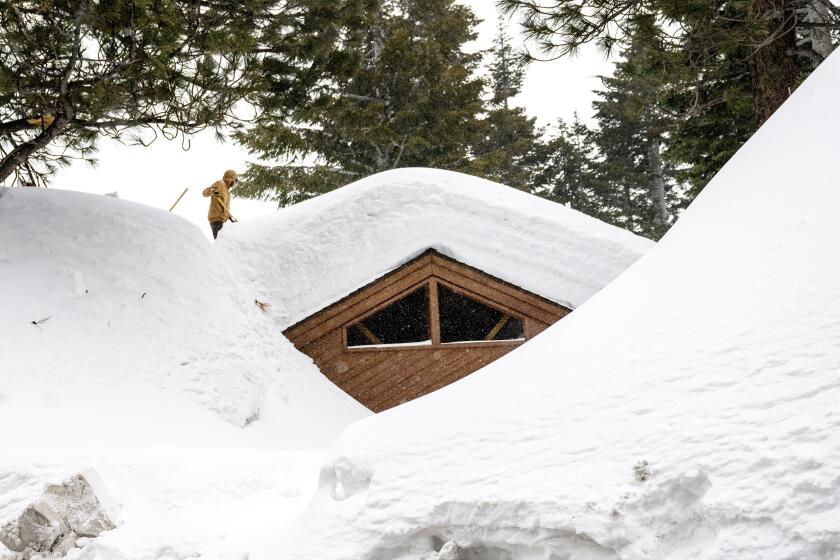San Joaquin Valley farmers dig in for the next battle: an epic Sierra snowmelt
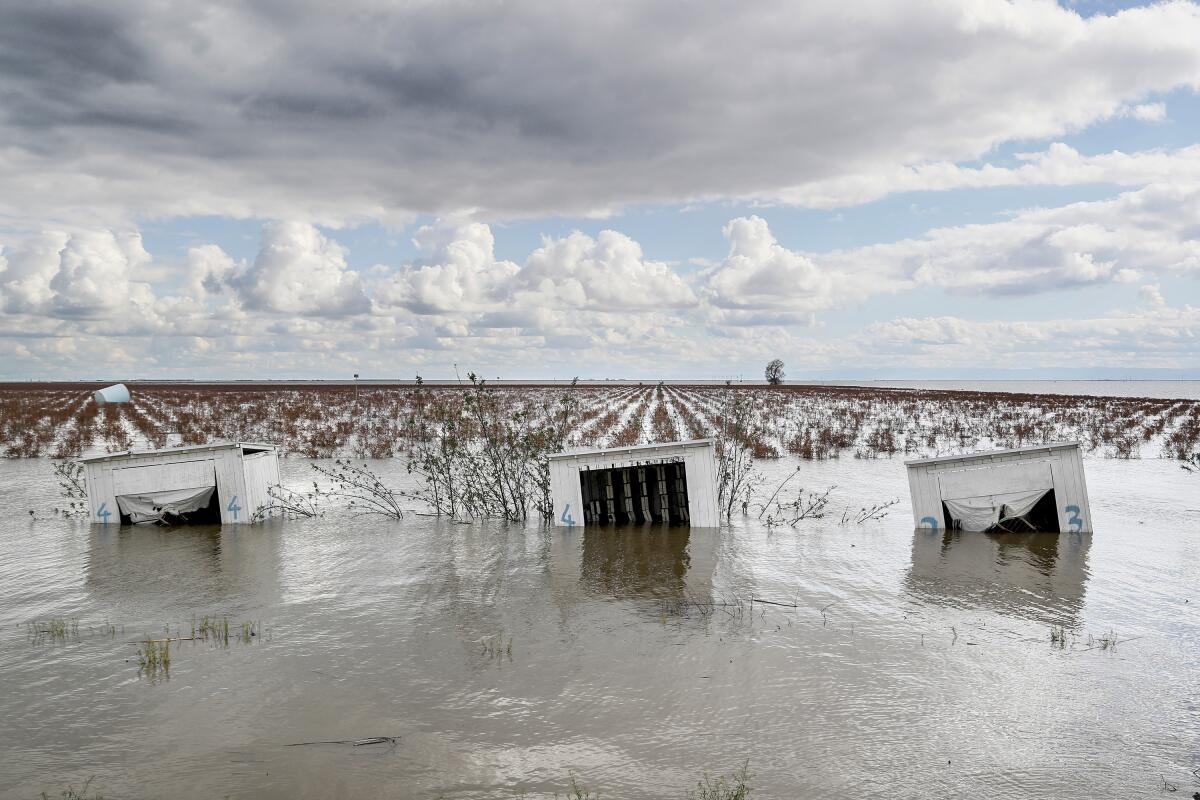
- Share via
CORCORAN — Tom Barcellos has farmed the reclaimed soil of the Tulare Lake Basin for nearly five decades, and he’s rarely witnessed a winter like 2023.
A slew of drenching storms, funneled across the Pacific Ocean as atmospheric rivers, have prompted prolonged flooding in large swaths of the San Joaquin Valley. For the first time in decades, Tulare Lake is reemerging from the valley floor, as rivers swollen with runoff from heavy rains and snow spill down from the Sierra Nevada into the valley, overwhelming canals and levees. The lake’s return has engulfed thousands of acres of cropland, orchards, highways and homes, upending the region’s economy, possibly for years.
And even as blue skies return, the flood-weary farmers have only to look east, to the towering Sierra mantled in historic layers of snow, to know there is worse to come.
Barcellos is awed — and exhausted — by what nature has wrought. But like other farmers with deep roots in this valley, he has no serious thoughts of leaving. Instead, he is digging in for battle.
“This is our livelihood,” said Barcellos, who owns both cropland and dairies. “This is more important than anything else, in my mind. And I thank God everybody has jumped in to fight.”
But there will be no quick victories.
For weeks now, farmers, their crews and residents of the nearby towns threatened by flooding have tromped through water, sludge and punishing storms to try to shore up the region’s defenses. Barcellos recounted a strenuous episode in early March when his team, armed with excavators and heavy machinery, set out to limit destruction along the surging Tule River, normally a “lifeline” for nearby dairies and more than 125,000 acres of crops.
Most years, the Tule River serves as a crucial irrigation line, ferrying Sierra snowmelt to the man-made channels and ditches that interlace the valley floor, redirecting the area’s major rivers with a strategic precision that has enabled landowners to transform these arid lowlands into an agricultural heartland.
And in the rare years of heavy rain and snowfall, the Tule is a critical release valve, ideally holding the heavy flows within its banks as it passes rural outposts like Porterville, Corcoran and the lucrative agricultural enterprises that crisscross the basin.
On this day, as the Tule hurtled along its banks, the concern was clearing the riverbed of accumulated refuse and debris to create room for heavy flows. Using a short boom like a claw in an arcade machine, Barcellos and his team worked for more than 20 hours, pulling out felled trees, heavy sediments, even a washing machine from the turbulent waters.
“We’re running on pure adrenaline,” Barcellos recounted, pointing to a pickup truck that was driven into the river in an attempt to stop the erosion. At one point, he had to rescue a friend from falling into the rapids surging through the sodden banks.
Despite their efforts, the force of the flood was too much to withstand, and “water six inches deep” soon began seeping into the adjacent fields and evacuated dairies, Barcellos said.
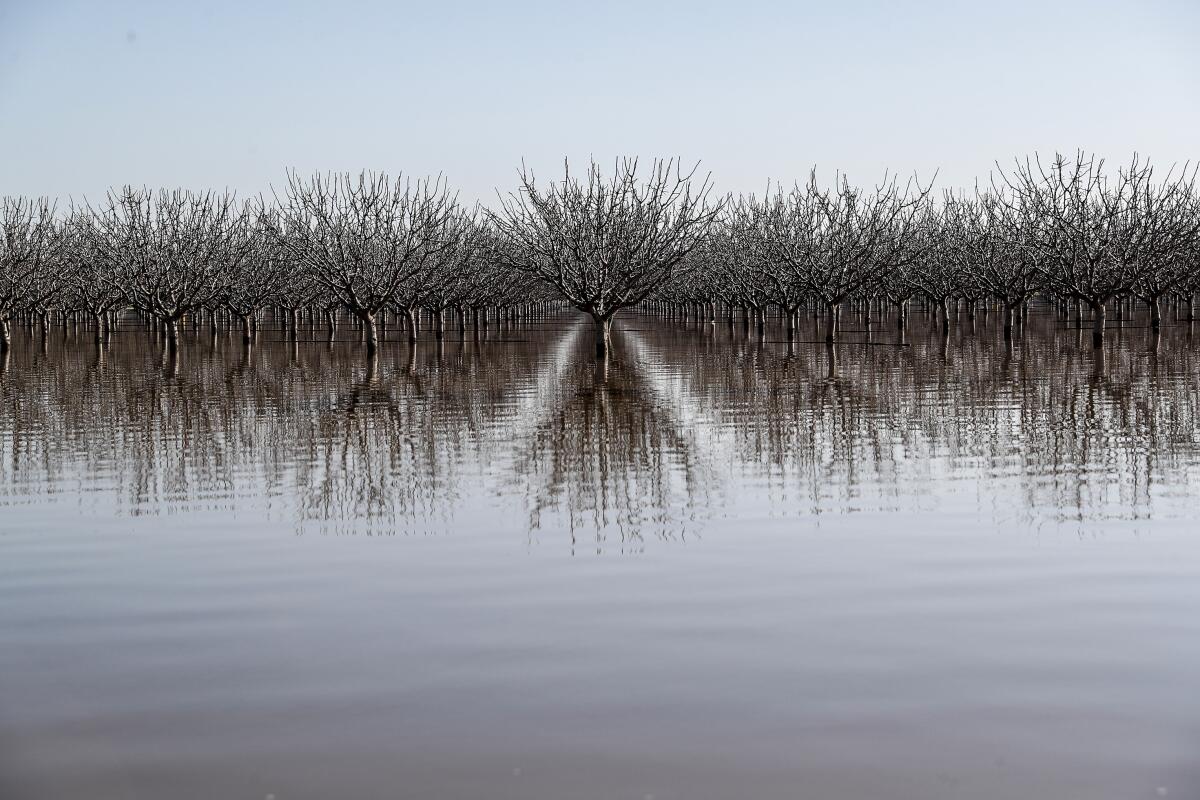
Roads, bridges and parts of the district’s irrigation system were swept away in the process. The dirt along the riverbed today looks as though somebody took a cleaver to a chocolate cake.
“It’s devastating,” Barcellos said. “We see there’s loss here that won’t recover.”
Once the largest freshwater lake west of the Mississippi River, Tulare Lake was largely drained by the early 20th century as the rivers that fed it were dammed and diverted for agriculture. In the days before the damming, the lake could stretch for 790 square miles, four times the size of Lake Tahoe, with depths of 30 feet.
This is not the first time the farms and ranches that now proliferate in the ancient lakebed have been threatened by the phantom lake’s reemergence. Its last high point was in 1983, when another period of heavy rain and snow unleashed massive runoff that suffused tens of thousands of acres and took some land out of production for years.

Barcellos is chair of the Lower Tule River Irrigation District, one of about a dozen reclamation districts that share responsibility for flood control in the Tulare Lake Basin. He estimates $1.5 million is needed to complete necessary repairs in his jurisdiction. “And that’s only this small area, on this system,” he said, wondering where the money will come from.
Richard Valle, a supervisor in neighboring Kings County, shared estimates for his county that top $1 billion in damage. “With the multipliers added — lost jobs, wages, etc.,” he said, “that takes us to $2 billion.”
Valle is among the local leaders who hope to tap federal assistance for storm response and recovery efforts. President Biden signed a major disaster declaration earlier this month to jump-start emergency aid to seven flood-battered counties, including Tulare. Kings County, omitted from the original request, has asked to be added to the emergency order.
The challenge going forward, Barcellos said, is managing the water for the remainder of the year. If orchards now engulfed in floodwaters aren’t drained, root rot will pose a risk to thousands of trees. The hay that feeds area cattle is also in danger.
And as temperatures warm, it is only a matter of time before a Sierra snowpack that is the deepest recorded in 70 years starts to melt, unleashing torrents of water that will further test the region’s defenses. Crews have a matter of weeks, maybe months, to reinforce levees and repair breaks.
“Normally, I could look to the east, and see snow as I scan north,” Barcellos said. “Now, I look to the east and there’s a lot of snow going to the south that is normally not there. That is going to have an impact.”
A wet winter has brought calamity to some parts of California. But in much of the state, the weather has ushered in a welcome recovery, nourishing crops, wetlands and threatened species -- and even proving a balm to the soul.
Robert Hansen, a retired biology professor and former president of the Tulare Basin Watershed Network, an environmental stewardship group, believes no amount of quick-hit reinforcements will be able to contain the water that would spew down the mountains if the region sees an early-season heat wave.
“It’s probably going to be the biggest flood I’ve ever seen,” Hansen said, recalling the flood of 1983 when he kept a canoe on hand in case he had to paddle into work.
“And the snow melts April to bloody July,” he said, meaning towns like Alpaugh, Allensworth and Corcoran, a trio of communities that sit in the lakebed, face a months-long risk of being wiped away.
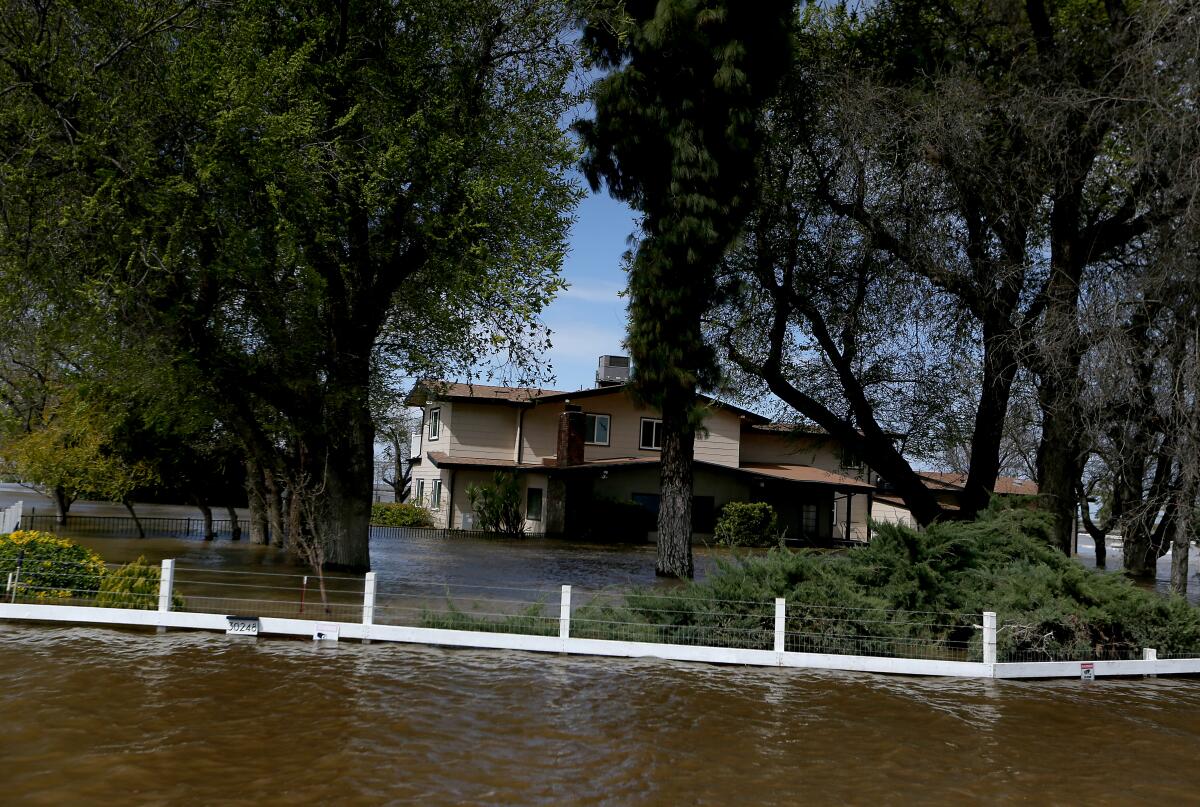
Corcoran in Kings County has a front-row view of the devastation. With about 22,000 residents, the town is home to a state prison that serves as a major employer, along with the region’s farms and dairies.
For the record:
1:05 p.m. April 19, 2023An earlier version of this story said the levee protecting Corcoran stands 188 feet tall. The levee stands 188 feet above sea level.
Corcoran is protected to the south by a long, mounding levee that stands 188 feet above sea level. On the other side of that defense, the reformed Tulare Lake continues to take shape, swallowing up pomegranate fields, barns and warehouses. The floodwaters lap against the levee banks and from there stretch miles to the horizon.
Like Barcellos, town residents are girding for the inevitable snowmelt, choosing — for now — to bolster defenses rather than evacuate. They are using excavators and heavy machinery to cart in mounds of dirt in hopes of raising the levee just enough.
“Unfortunately, we’re not getting a whole bunch of information or resources from the county, the state or the federal government,” City Manager Greg Gatzka said.
The water level on the outer side of the levee sits at 178 feet above sea level, 10 feet below the rim. Gatzka said the aim is to raise the levee by 4 feet. “Anything above and beyond that,” he said, probably won’t matter because the entire valley could be underwater.
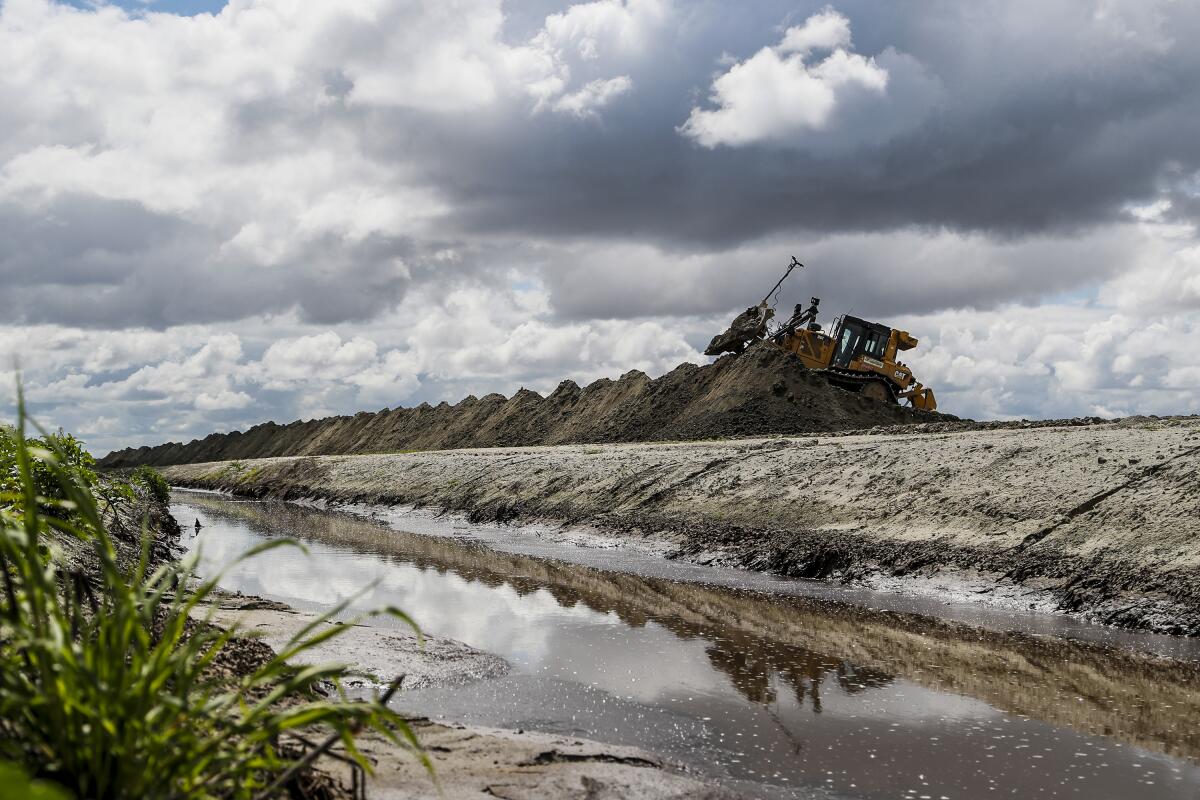
Partnering with the Cross Creek Flood Control District, the city hopes to haul in 150,000 cubic yards of dirt, enough to pack a 14-mile stretch. The work has been complicated by travel conditions: Roadways throughout the basin remain underwater, and access to and from Corcoran has withered to just two routes.
Coming up with the $17 million needed to finance the reinforcements is another problem. But waiting on construction was not an option, because as the water rises, the banks will become muddier, making it difficult for heavy equipment to maneuver. As it is, Gatzka estimated the work will take two months.
And with temperatures rising, “We do not have the luxury of time,” Gatzka said. “We have to be proactive if we’re going to have the best shot at protecting the city.”
Epic snowfall at Mammoth Lakes has become a nightmare for residents of this California ski resort community.
Corcoran residents and inmates in the prison, which sits at the lowest part of the city, will have to seriously consider evacuation if water levels reach 184 feet before the reinforcements are completed, Gatzka said. He thinks it’s likely the town will be at risk of flooding for anywhere from seven months to two years.
Assuming the town survives, the economic fallout is hard to predict, Gatzka said. Most residents are farmhands and dairy workers, so their fate hinges on which agricultural properties stay dry and when cultivation can resume in areas that flooded. Despite the unknowns, he maintains faith.
“It’ll be a struggle all across the valley,” Gatzka said. “But we’ll weather through it.”
More to Read
Sign up for Essential California
The most important California stories and recommendations in your inbox every morning.
You may occasionally receive promotional content from the Los Angeles Times.

